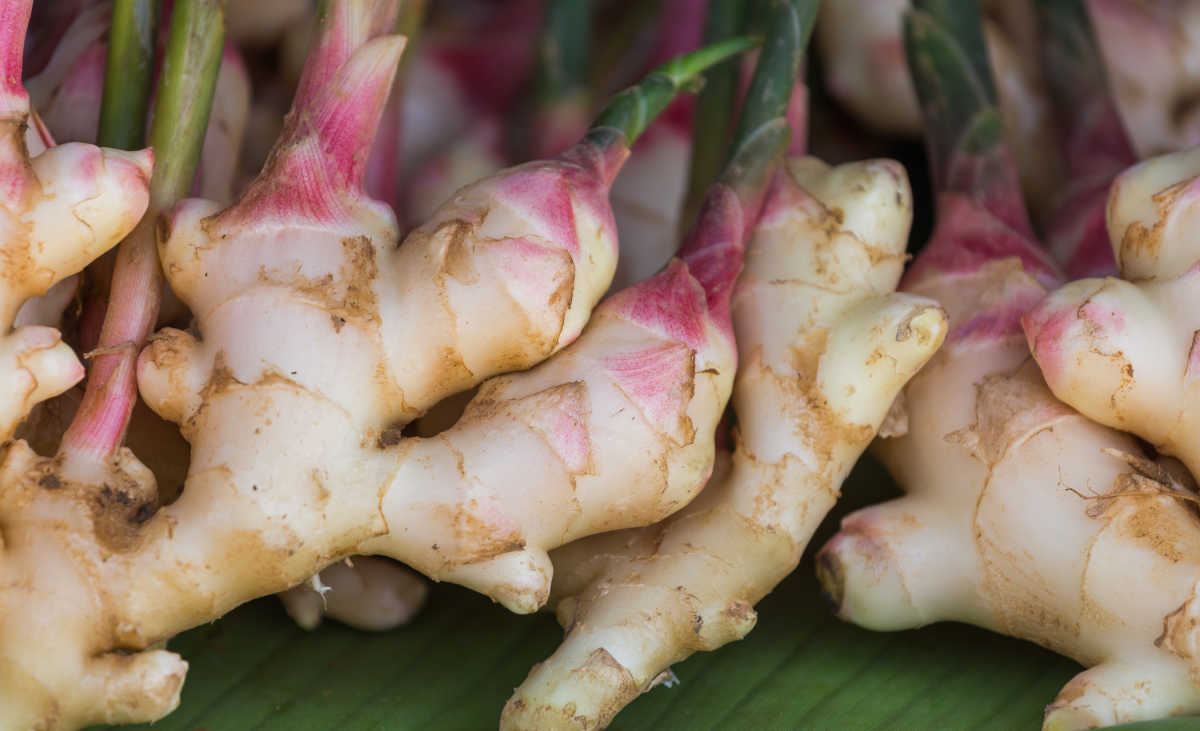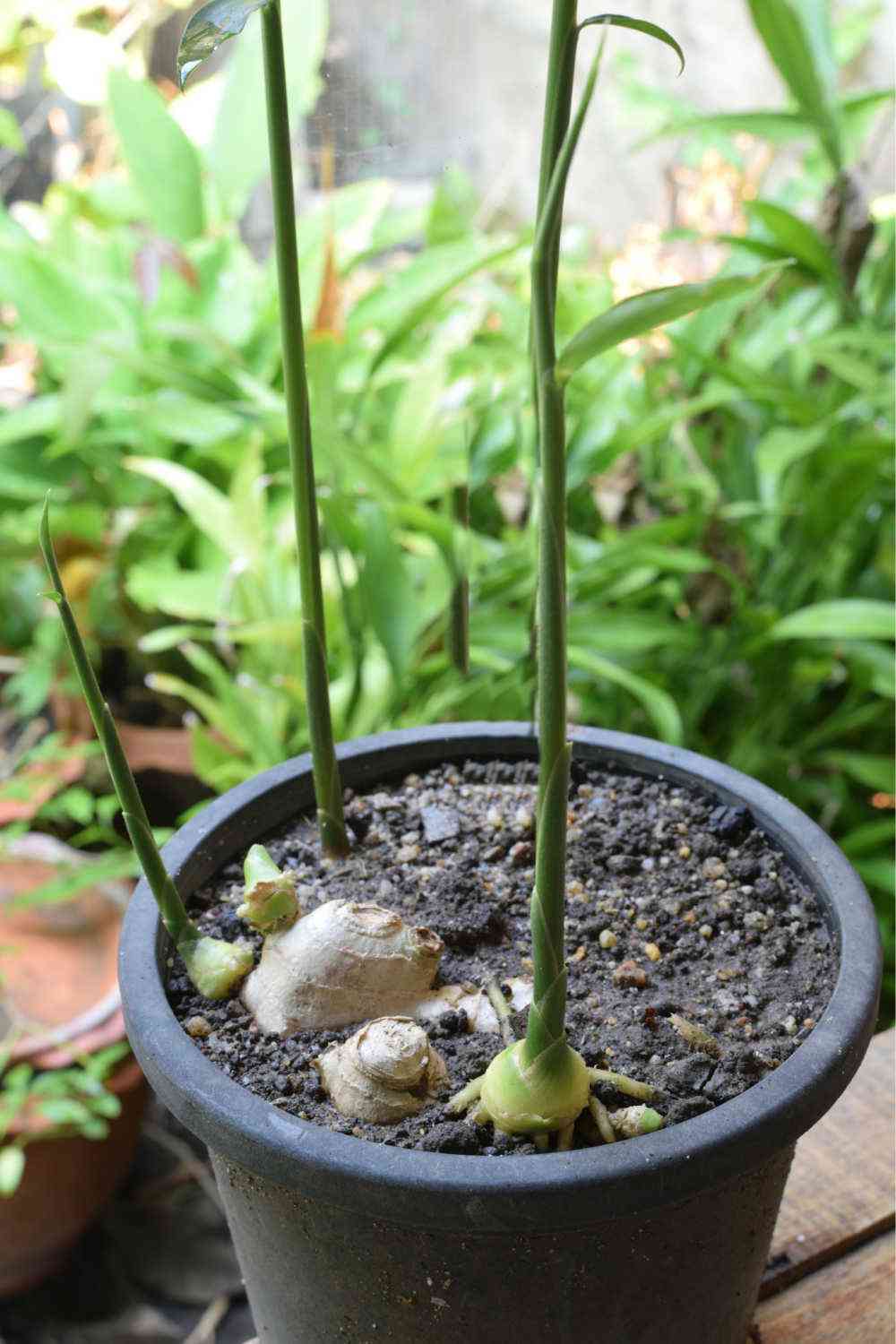How Easy is It to Grow Ginger Outside
Growing ginger from root is a fun kid's project. Ginger is a tropical plant that is easy to grow indoors.
All you need is a piece of fresh ginger, some water and some soil to get a plant growing.
It seems that I am on a growing from scraps kick lately. There are many vegetables that can be grown from their parts and pieces. Ginger root is just one of them.
This aromatic plant will root easily from just a part of the plant. You can always have some growing in your garden to use in recipes!
I've written a whole article on this topic. To read about other foods that will re-grow from kitchen scraps, see this post.

Share this post about growing ginger from root on Twitter
Grow your own ginger plant from a piece of ginger root. Find out how to do it on The Gardening Cook. #growingginger #organicgardening #vegetablegarden Click To Tweet
What is ginger root?

Brush up on your knowledge of ginger root with these fun facts:
- Botanical name – zingiber officinale
- Common name – fresh ginger, ginger root, cooking ginger, stem ginger, Canton ginger
- Type – herbaceous perennial shrub
- Native to – Southeast Asia
Ginger – zingiber officinale – is a popular kitchen ingredient that can be used in all sorts of recipes, from Asian dishes to zesty salads and delicious homemade gingerbread.
If you enjoy the flavor of ginger in gingerbread cookies, be sure to check out the history of gingerbread. It's fascinating!
Ginger root has been used in Indian and Chinese cooking since ancient times. It has a sweet, but spicy flavor that is very versatile.
The plant is grown, not for its foliage, but for its aromatic and spicy rhizomes, which are called ginger roots.
Ginger is a vegetable but is often referred to as a herb or spice. Many cooks consider dried ginger a spice and fresh root a herb.

The active components in ginger are called gingerols which give the root its distinctive flavor. Gingerols are thought to be anti-inflammatory and useful in alleviating arthritis pain.
Ginger root rhizomes are firm and knotty with a rough texture. The flesh can vary in color from yellow to red, depending on the variety.
We don't often see ginger growing farms in the USA since ginger is considered a tropical plant. Most of the ginger that we find in our grocery stores has been grown in China, West Africa, India, or Indonesia.
For most areas of the USA, ginger is grown as an annual. In some warmer climates such as the South West, Florida and Hawaii, ginger can be grown year round
Today, we'll learn about growing ginger at home from a piece of ginger root.
Growing ginger from store rhizomes – can it be done?
It is possible to grow a ginger plant from ginger purchased at the grocery store. However, your results might be inconsistent with those shown below.
The reason is that ginger purchased from the produce department of a grocery store is sometimes sprayed with a growth inhibitor to keep it from sprouting before it has been purchased.
This growth inhibitor may also keep it from sprouting when you place the ginger root in a pot of soil.

For best results with store ginger, soak the rhizomes in water overnight in case they have been sprayed with an inhibitor.
The best source of ginger for re-growing is from rhizomes that have been supplied by an organic grower, or from your local Farmer's Market.
You can also order organic ginger pieces from many online sellers. (affiliate link)

Growing ginger from root
In spite of its preference for tropical climates, rowing ginger root is a lot easier than one might think.
All that you need to grow ginger is a piece of ginger root. In no time at all, you will have a ginger plant growing.
Preparing ginger root for planting
Choose pieces of ginger root that are plump with well developed eyes or growth buds. An ideal piece of ginger is about four to six inches long with multiple "fingers" extending from it.
Avoid any pieces that are shriveled or dry looking. If you find a piece of ginger that has already sprouted, that is fine. It will likely grow well.

You will need to prepare your ginger root before planting it. Cut the ginger root into pieces that are about 1 to 1 1/2 inch wide. Be sure each piece has at least one eye.
Allow the cut areas of your pieces to callous over for a 24-48 hours.
How to sprout ginger from its root
Once your cut pieces of ginger have calloused over, place them into some organic potting soil. (affiliate link) Make sure the healthiest looking eyes are facing upwards.

Ginger root likes rich, damp and fertile soil that has been amended. This type of soil absorbs water well but doesn't get soggy.
Adding compost or other organic matter will help with drainage. Ginger root plants like a soil that is slightly acidic (5.5 to 6.5). Adding coffee grounds to the soil can help to raise its acidity.
Place the pot of ginger pieces in filtered light, but not in direct sunlight. This makes ginger a good indoor plant. Growing ginger indoors in a pot is also a good choice for gardening with children since the kids will be able to watch it sprout and grow nearby.
Ginger can also be planted directly into the ground outdoors as soon as any danger of frost has passed and temperatures are consistently above 60° F.
For outdoor plants. a shady to filtered sunlight location, such as one under the shade of a tree, is ideal. Ginger plants like heat and humidity.
When should I plant the rhizomes?
The best time for planting ginger outdoors in cooler climates is in the early spring. In warmer temperature zones, you can plant any time of the year.
For indoor plants, place ginger root pieces in pots that are large enough to accommodate the growing rhizomes. If you use a larger pot, you can plant more pieces in the container.
Make sure the pot drains well, and that the soil is rich and fertile.
Place one piece of ginger root in each pot. If planting ginger outdoors, space the pieces 12 inches apart.
Plant each piece of the rhizome about 1 inch deep and keep adding soil over the rhizomes as they grow and multiply.
Water well after planting.
Care of your ginger plant
Pieces of ginger root take about 1-2 weeks to start growing leaves. This means the roots are starting to form under the soil. Gently water until you see more growth and then keep consistently moist after the growth starts.
Your ginger plant will eventually grow up to 4 feet tall. Some of the roots will appear above the ground, which is normal for plants grown from rhizomes. (My iris plants always grow this way.)

The plant has narrow, glossy bright green leaves and yellowish green summer flowers that are rarely seen.
Growing ginger root needs about 8-10 months for the plants to reach maturity but the roots can be harvested after about 2 months.
Feed ginger plants once a month during the growing season.
Pest and diseases for ginger
Ginger is considered relatively free of pests and diseases.
Some diseases that may affect ginger are leaf damage from pests, bacterial wilt, fusarium fungus and nematodes that affect the roots.
Root rot is also possible if you water too much.
Bugs that are could be attracted to ginger are ants, aphids, mealy bugs, cut worms and spider mites. Slugs and snails also have a fondness for the plant.
Harvesting ginger grown from root
To harvest ginger, just dig it up. Rinse away the dirt under running water and it will be ready to use in your recipes.
This method of harvesting works best if you have lots of ginger plants growing.
If you would like to keep the plant growing, but still want to harvest some ginger root to use, you can harvest part of the rhizome. To do this, use your hands to feel the rhizome under the soil.

Choose a piece that is at least 2 inches away from the stalk and cut the outer part of the rhizome with a sharp knife. You can use this piece but the plant will continue to grow under the soil.
Harvesting this way will will give you an endless supply of ginger.
Harvesting ginger grown in pots
To harvest ginger grown in indoor pots, dig up the entire plant, cut off a piece of the ginger root and replant the rest of the rhizome. As long as you leave at least 2 inches of the rhizome left, the plant will continue to grow.
Harvesting is good for the mother plant, since ginger root loves to spread.

If your garden patch or pot of ginger is pushing up multiple stalks, you will know it is time to start a new pot, In time, you may have quite a few containers of ginger root.
Hardiness zones for ginger plants
Ginger is only cold hardy in zones 9-12, although there are a few varieties of ginger that are hardy down to zone 7.
Ginger has a tendency to go dormant when temperatures go below 55°F even in warmer climates. The foliage will die off but the rhizome will still be viable.
However, once the temperatures go below freezing – 32°F, the rhizome will shrivel and become lifeless. Ginger root cannot tolerate frost at all.
Fortunately for those of us who live in the cold zones, ginger is easy to grow in a pot.
If you have your ginger root in a pot outside, be sure to bring it indoors before the temperature is expected to dip below 55°F if you live in the colder hardiness zones.
Another alternative is to plant ginger in the ground outdoors, but dig the rhizomes up when the weather starts to get cooler. You can keep them in pots over the winter and replant in the ground in spring.
Admin note: This post for growing ginger from root first appeared on the blog in April of 2013. I have updated the post to add more growing tips and facts, a project card with printable growing tips, new photos and a video for you to enjoy.
Pin this post for growing ginger from root
Would you like a reminder of this post for how to grow ginger root? Just pin this image to one of your vegetable gardening boards on Pinterest so that you can easily find it later.

Prep Time 2 days
Active Time 2 months
Additional Time 8 months
Total Time 10 months 2 days
Difficulty easy
Estimated Cost $5
Materials
- I piece of fresh ginger root with eyes, 1 to 1 1/2 inches long.
- 8" pot
- Well draining potting soil
- Compost or other organic matter
- All purpose fertilizer
Instructions
- Cut fresh ginger root into 1 1/2" pieces.
- Allow the pieces to callous over for 24-48 hours.
- Plant each of the cut pieces into an 8" pot with well draining soil that has been amended with compost or other organic matter.
- Give the plant bright indirect light but not full sunlight.
- Water well. Leaves should sprout in a few weeks.
- The rhizomes will be ready to harvest in two months.
- The plant will take about 8 months to reach maturity.
- Only hardy in zones 9 and above.
- Bring indoors before the temperatures drop below 55° F.
- Cannot tolerate any frost.
- Watch for spider mites, aphids, and ants.
Source: https://thegardeningcook.com/growing-ginger/
0 Response to "How Easy is It to Grow Ginger Outside"
Post a Comment